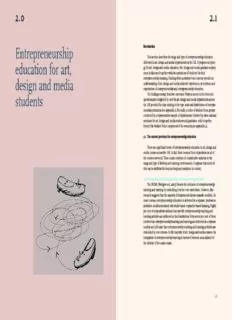
2 Entrepreneurship education for ADM students PDF
Preview 2 Entrepreneurship education for ADM students
2.0 2.1 Introduction Entrepreneurship Thissectiondescribestherangeandtypeofentrepreneurshipeducation deliveredinart,designandmediadepartmentsintheUK.Itproposesatypolo- education for art, gyforart,designandmediaeducation.Art,designandmediagraduateemploy- mentisdiscussedtogetherwiththeaspirationsofstudentsfortheir entrepreneurshiplearning.Findingsfromastudentvoiceexerciseprovidean design and media understandingofart,designandmediastudents’experiences,perceptionsand expectationsofentrepreneurshipandentrepreneurshipeducation. Thefindingsemergefromtwoexercises.Firstlyasurveyintheformofa students questionnairecompletedbyover80art,designandmediadepartmentsacross theUKprovidedthedatarelatingtothetype,scaleanddistributionofentrepre- neurshipeducation(seeappendix1).Secondly,aseriesofstudentfocusgroups conductedinarepresentativesampleofdepartments,followedbythreenational seminarsforart,designandmediastudentsandgraduates,whichtogether formedtheStudentVoicecomponentoftheresearch(seeappendix2). 2.1 Thecurrentprovisionforentrepreneurshipeducation Therearesignificantlevelsofentrepreneurshipeducationinart,designand mediacoursesacrosstheUK.Infact,thereissomeformofprovisioninallof thecoursessurveyed.Thereisalsoevidenceofconsiderablevariationinthe rangeandtypeofdeliveryandlearningenvironments.Itappearsthatmuchof thiscanbeattributedtolocalandregionalvariationsincontext. Howareteachingandlearningactivitiesinentrepreneurshipdelivered? TheDCMS(Wedgewood,2005)favourstheinclusionofentrepreneurship teachingandlearningbyembeddingitinthecorecurriculum.However,this researchsuggeststhatthemajorityofdepartmentsfavourseparatemodules.In mostcourses,entrepreneurshipeducationisdeliveredinaseparate,profession- al-studiesmodelassimilatedintostudio-basedorpractice-basedlearning.Eighty percentofrespondentsindicatethatspecificentrepreneurshipteachingand learningactivitiesaredeliveredattheirinstitution.Forty-sevenpercentofthese confirmthatentrepreneurshipteachingandlearningaredeliveredinaseparate moduleand31%statethatentrepreneurshipteachingandlearningactivitiesare embeddedincorecourses.Inthemajorityofart,designandmediacourses,the integrationofentrepreneurshiplearningisfavouredbutseenasanadjunctto thedeliveryofthemaincourse. 37 2.1 Figure1:Howareteachingandlearningactivitiesdelivered? Eighty per cent of CreativeIndustries respondents indicate that Separatemodule/unit BusinessStartUp Fullyintegrated Individualclasseswithin module specific entrepreneurship Shortcoursedelivered Externalagencydelivers withCIpartner support teaching and learning Varies Liveexternalprojects Studentprojectsoutside &competitions ofspecificmodule activities are delivered at their institution. Onlyaminority(24%)siteentrepreneurshipteachingandlearningactivities withingeneralbusinessstudiescourses.Theemergenceofspecificmodulesfor entrepreneurshipeducationanditsintegrationintopractice-basedmodulesand subject-specificprojectworksuggeststhatcurriculumdevelopersareawareof Most course curricula include distinctionsbetweentechnicalbusinessskillsandtheneedtodevelopentrepre- neurialcapacityingraduates. Mostcoursecurriculaincludecombinedmodelsofdelivery.Over80% combined models of delivery. embedtheteachingandlearninginproject-basedworkandbetween50and 90%ofthetotalentrepreneurshiplearningisdeliveredinthesecontexts. Over 80% embed the teaching Around10%suggestthatthelearningisembeddedinasingleprojectdesigned toassiststudentsinapplyingentrepreneurialthinking.Tenpercentclaimthat thislearningisembeddedinallpractice-basedandproject-basedlearning.The and learning in project-based remainderaredividedequallybetweencourseswherethelearningisembedded inmostorafewprojects. work and between 50 and 90% Figure2:Whereisthelearningembeddedinpractice? of the total entrepreneurship Inallprojects learning is delivered in these Inmostprojects Singleprojectdesignedto support contexts. learningaboutentrepre- neurship Inafewprojects 38 CREATINGENTREPRENEURSHIP 39 2.1 Wherethereisevidenceoffree-standingmodulesrelatingtoentrepreneur- Seventy per cent of the shipthereisalsogreateremphasisonapplyingthisinawiderrangeofproject work.Thissuggeststhatasentrepreneurshiplearningbecomesamoresignifi- courses surveyed cantfactorinthecurriculum,distinctionsbetweenentrepreneurshippractices andcreativepracticesbecomelesssharplydrawn.However: assess • Thereisconflationofcreativepracticeandentrepreneurship.Thatis, creativityisthoughtofasaproxyorsynonymforentrepreneurship(entrepre- entrepreneurship neurshipisembeddedinallprojectswithlittleseparatedelivery). learning outcomes. • Whileontheotherhand,inasignificantproportionofcoursesthereis atendencytosetentrepreneurshipinoppositiontocreativepractice(entrepre- neurshipisembeddedinasingleproject). Theassessmentofentrepreneurshiplearningoutcomes Seventypercentofthecoursessurveyedassessentrepreneurshiplearning outcomes.Inthosecoursesthatincludefree-standingentrepreneurshipeduca- tionmodules,assessmentofoutcomesisspreadbetweentheseandpractice- AROUND 50% OF ASSESSMENT OF basedandproject-basedlearning.Thereisawiderangeofassessment instruments:themostcommonisacriticalreport,relatingtoeitherthestu- dents’projectworkinanacademiccontextoroncritical,work-basedlogbooks ENTREPRENEURSHIP RELATED focusedonsomeformofreflectiononwork-basedlearningexperiences. Figure3:Theassessmentofentrepreneurshiplearningoutcomes LEARNING OUTCOMES IS BASED ON APPLIED LEARNING AND Criticalreportontheirown Assignments,projects& project exams Productionofbusinessplan Presentationofwork LEARNING IN THE WORKPLACE. Seriesofformalassignments Alignmentthroughnormal studies Variesfromcoursetocourse Reflectivelearningjournal Workbasedlogbooks,critical reportontheirownproject Groupexhibition Integratedwithstudio Alloftheabove assessment Itisheldtobegoodpracticeineducationtoalignassessmentwithlearning outcomes.Around50%ofassessmentofentrepreneurshiprelatedlearningout- comesisbasedonappliedlearningandlearningintheworkplace,suggesting thatteaching,learningandassessmentactivitiesrelatingtoentrepreneurship educationinart,designandmediacurriculaarebeingcarefullyplanned. Thebusinessplanmaybevaluableasaninstrumentalbusinessskillbutfairly 40 41 2.1 limitedasanindicationofentrepreneurialthinking,howeveritfeaturesasakey It is difficult to form a elementinassessment.Itisdifficulttoformacoherentviewofwhatlearning outcomesareassessedandthereisawiderangeofinterpretationsofwhatcon- stituteseffectiveentrepreneurshiplearningoutcomes. coherent view of what Entrepreneurshipeducationissupportedbyspecialistteachers learning outcomes are Specialistteachersarehighlyvaluedwithinart,designandmediacourses acrosstheUK.Eighty-eightpercentofrespondentsconfirmthatspecialistsplay assessed and there is a akeyroleindeliveryandsupportforentrepreneurshipeducation.Theproportion ofspecialistsdeliveringentrepreneurshipeducationrangesfromzeroto100%. Onaverageonly10%ofentrepreneurshiplearningisdeliveredbyspecialists. wide range of Figure4:Theproportionofentrepreneurshipeducationdeliveredby interpretations of what specialists constitutes effective 0to10 11to20 21to30 entrepreneurship learning 31to40 41to50 outcomes. 51to60 61to70 71to80 81to90 91to100 Eighty-eight per cent of However,contributionsbyspecialiststoentrepreneurshipeducationmight respondents confirm that representarelativelysmallproportionofacourse.Thereisalackofclarity aboutwhatmightconstituteaspecialist.Thismaybeateacheroutsidetheprac- specialists play a key role in ticeforexampleabusinessspecialistorlawyer.Therearesomecourses, althoughtheyareaminoritythat‘buy-into’orhavespecialistmodulesdelivered byotherdepartments,forexampleabusinessschool.Often,aspecialistisany delivery and support for contributorwhoisnotafull-timeacademic.Significantnumbersofpart-timeor fractionalteachersmayalsoworkinthecreativeindustries.Insmallercourses, teacher-practitionersmaydeliveralmosttheentirecurriculum.Whereteacher- entrepreneurship education. practitionersareconsideredspecialists,theproportionofspecialistsdelivering entrepreneurshipeducationisdrivenupwards.Manydepartmentsseeemploy- design sector. ingteacher-practitionersasakeyinstrumentforensuringcoursecontentand deliveryisalignedwithreal-worldpractice. 42 CREATINGENTREPRENEURSHIP 43 2.1 2.1 Entrepreneurshipeducationissupportedbyinstitutionalfacilities Figure6:Extra-curricularsupportforentrepreneurshipdevelopment. Ninety-sixpercentofrespondentsreportthattheirstudentshaveaccessto institutionalfacilitiesandprogrammessupportingentrepreneurshiplearning. Innovationor Liveassessedprojects Thesemaybestructuredlearningexperiencesdeliveredincollaborationwith entrepreneurshipscheme Shortcoursesavailableto oneormorecreativeindustriespartners.Around30%reportcollaborationswith Studentsbecomeengagedin graduates creativeindustriespartners.TheCoxReview(Cox,2006)advocatestheneedfor professionalinteractionswith Informalprogrammeof moreandstrongerlinksbetweenuniversitiesandsmalltomediumsizedenter- eachother engagement prises(SMEs)andemphasisesthattherearebenefitstoSMEs,institutionsand Formalprogrammesof Fundedprojects engagementwithcommerce students.Coxsuggeststhatthroughthisengagement,smallercompanieswill Creativegraduate andindustry developmentprogramme benefitfromthespecialistknowledgeavailableaswellasfromresearchcapabili- Careersdevelopment Externaltrainingcourses ty,accesstofacilitiessuchasprototypingandpotentialrecruitment.Equally orientatedtowards institutionswillbenefitfrommoreopportunitiestotryoutideasinpractice, entrepreneurship AimHigherInitiatives Externalcompetitions placementopportunitiesandaccesstoalargepartofindustry.Althoughengage- mentatthelevelofcoursedeliveryissignificant,thereisprobablyopportunity toenhancethis. Figure5:Institutionalsupportforentrepreneurshipeducation Despitehighnumbersbelievingthatstudentsbenefitfromsuchschemes, only33%identifiedspecificextra-curricularprogrammessupportingentrepre- neurshipdevelopment.Entrepreneurshipeducationcanfinditswayintoa broadswatheofthecurriculumbutlearningoutsidethecurriculumisalsoan InsightOut importantpartofthestudentexperience(UUK,2002). IncubationCentre CETL’s InnovationUnit Specialistteaching&learn- Fundingforsupportingstudentandgraduateentrepreneurship Partnershipwiththe CreativeIndustries ingfacilities TheHigherEducationFundingCouncilssupport22%oftheprogrammes Youngenterprisegraduate ECCAdeliversmostofthe identifiedinthissurvey,inadditiontotheHigherEducationInnovationFund items programme (15%),theRegionalDevelopmentAgencies(14%)andtheEuropeanSocialFund BDU Enterpriseprogramme (12%).Asignificantproportionoffundingisinitiativefundinganditisnotclear Allofabove thatsustainabilityisbuiltintodelivery.Respondentsindicatingthatfundingis fromtheHigherEducationFundingCouncilsmayhaveaddressedthisbylocat- ingentrepreneurshipeducationincoremodules. Entrepreneurshipeducationissupportedbyextra-curricularfacilities Asimilarlyhighnumberreportthatstudentsbenefitfromawiderangeof facilitiesandprogrammessupportingentrepreneurshipbutnotaimedat assessedlearningwithinthecurricula.Mostoftheseareaimedinsteadatthe careerdevelopmentofstudentsandmanyareopentoalumni.Thereissome overlapbetweenthesupportforaccreditedandfornon-accreditedlearningand someacademicprogrammescallontheexpertiseofenterprisecentreswithin theirinstitutiontosupportlearningandcareerdevelopment.Thereislittleevi- dencewithinthesurveydataoftheeffectivenessoftheseschemes,but82%of respondentsbelievethattheirstudentsdirectlybenefitfromfacilitiesandpro- grammessupportedbythedepartmentorinstitution. 44 CREATINGENTREPRENEURSHIP 45 2.1 1.0 Figure7:Fundingofentrepreneurshipeducationforart,designandmedia enterprisesinrelationtolargemetropolitaninstitutionspresentsdifficultiesfor students bothcourseteamsandcreativeindustriespractitionersinformingeffective links.TheMidlandsandtheNorthWestdohoweverreportasignificantlevelof entrepreneurshipeducationdeliveredthroughcreativeindustriespartnersand SectorSkillsCouncil Third-legFunding therearealsosignificantlevelsofcreativeactivityintheseregions. HEIF NESTA HEFCE SIE Figure8:Rangeofentrepreneurshiplearningsituations,byregion(Fig.2b) EuropeanSocialFund LocalCityCouncil ArtsCouncil CreativeIndustry RegionalDevelopment Partnerships 12 Agency StudentInitiatives DepartmentofTradeand 10 ArtsCouncil Industry 8 RegionalEconomicInitiative 6 4 ThereareothersupportersincludingNESTA,ArtsCouncilEngland,the 2 DTI,andtheSectorSkillsCouncils.Fundingbylocalauthorities,creativeindus- 0 triespartners,regionalofficesoftheArtsCouncil,theRegionalEconomic (cid:1) Separatemodule (cid:1) Dedicatedcourse InitiativeandtheRegionalDevelopmentAgenciestargetedatbenefitsforthe (cid:1) Individualclasseswithinmodule (cid:1) Partofcreativebusinessstartuppro- regionsrepresentasignificantproportion(25%)ofthetotalfundingsupporting (cid:1) Shortcoursesdeliveredinpartnershipwith gramme entrepreneurshipeducation. citybasedmediacentre (cid:1) Externalorganisation (cid:1) Fullyintegrated (cid:1) Specificunt Regionalvariationsintheprovisionofentrepreneurshipeducation (cid:1) Alloftheabove Thereissomealignmentbetweenthenumberofresponses,thedistribution ofthecreativeindustries,andthedensityofart,designandmediaprovision. Forexample,28%oftheresponseswerefromdepartmentslocatedinLondon andtheSouthEastofEngland.TheCreativeIndustriesMappingDocument Amorestraightforwardrelationshipexistsbetweentherangeoffunding (DCMS,1998,2001)showsastrongconcentrationofcreativeindustriesin agenciessupportingentrepreneurshipeducationandthevarietyofcontextsin LondonandtheSouthEast,accountingforhalfofallcreativeindustriesemploy- whichentrepreneurshipeducationisdelivered.London,theSouthEast,South eesintheUK.Theseregionsalsohavethegreatestnumberofart,designand WestandNorthEasteachbenefitfrommorethanfourdifferenttypesofexter- mediastudentsstudyinginthehighestconcentrationofinstitutions. nalfundingincludingRegionalDevelopmentAgencies(RDA),Higher TheEastMidlands,London,NorthWest,SouthWestandWestMidlands EducationInnovationFund(HEIF),HigherEducationFundingCouncil eachrepresented10-11%ofthetotalresponses.Theseregionshaveastrongpost- (HEFC),ArtsCouncil,DTI,SectorSkillsCouncilandthirdlegfunding. industrial/manufacturingbaseanddepartmentsintheseregionshaveahigher levelofengagementwithcreativeindustriesandspecialistteachingandlearning facilities.Regionswithlowerresponserates-theEastofEngland,Wales,North East,YorkshireandHumberside-havelowerlevelsofcreativeindustriesactivi- ty,fewerart,designandmediacoursesandthereforelowernumbersofstu- dents.Entrepreneurshipeducationintheseregionsissupportedmainly throughinstitutionalinitiativesandsupportnetworks,includinginnovationand incubationunits. OnemighthaveexpectedthatrespondentsinLondonandtheSouthEast wouldrecordthehighestlevelofpartnershipswiththecreativeindustries,how- everthisisnotthecase.Itmaybethatthevolumeofmicroandsmallcreative 46 CREATINGENTREPRENEURSHIP 47 2.1 2.1 Figure9:Rangeoffundingtoentrepreneurshipeducation,byregion(Fig4b) 2.1 Summary • Themajorityofentrepreneurshipteachingandlearningskillsaredelivered 12 throughasubject-specificmoduleforentrepreneurshipandnotaspartofa generalbusinessstudiescourse. 10 8 • Themajorityofentrepreneurshipteachingandlearningisalsointegrated 6 intopractice-basedandproject-basedlearning. 4 • Ademonstrationofentrepreneurialskillsformspartofundergraduateand 2 postgraduateassessmentinthemajorityofart,designandmediacourses. 0 • Art,designandmediacoursesthatdeliverentrepreneurshipeducationasa separatemodulearemorelikelytoincludeademonstrationofentrepreneur- ialskillsaspartofstudentandgraduateassessment. (cid:1) RDA (cid:1) ArtsCouncil (cid:1) EuropeanSocialfund (cid:1) DTI • Specialistpractitionersmakesignificantcontributionstoentrepreneurial (cid:1) LocalCityCouncil (cid:1) SectorSkillsCouncil learning.Thisisbelievedtobeakeyfeatureofentrepreneurshipeducation (cid:1) HEIF (cid:1) ThirdLegFunding inart,designandmedia. (cid:1) HEFCE (cid:1) NESTA • Entrepreneurshipskillsareassessedinwork-basedlogbooks,criticaland TheEastofEngland,NorthernIreland,NorthEast,Wales,WestMidlands, reflectivereportsonstudentprojects. YorkshireandHumbersidehavetheleastrangeoffundinginitiatives.Theydo • receiveadditionalHEFCfundstosupportentrepreneurshipeducationforart, Moststudentsandgraduateshaveaccesstoinstitutionalfacilitiessupport- designandmediabuttheyalsoreportlessvarietyinthekindsofsupport ingentrepreneurshipeducation. offeredtostudents.Institutionsintheseregionsaremostlikelytorelyonsub- • ject-specificentrepreneurshipmodulesandonlearningthatisembeddedin Themostcommonsupportforstudentandgraduateentrepreneurshipis practice-basedandproject-basedlearning.Howeverthereislittleevidenceto throughpartnershipswithcreativeindustriesandthroughenterprisedevel- suggestthatgreatervarietyinitselfoffersanymeasurablebenefitintermsof opmentprojects.HowevertherearevariationsacrosstheUKinthescaleof enhancedlearningoutcomes. provisionandbalancebetweenthetwo. • Networksand‘soft’supportfordevelopingentrepreneurshipeducation Moststudentsonart,designandmediacourseshaveaccesstoandaresup- Althoughthissurveywasnotdesignedtorevealtherangeofinformalor portedbyinnovationand/orentrepreneurshipschemesduringandafter ‘soft’systemsforsupportingentrepreneurshipeducationinart,designand theirtimeatuniversity. media,itisclearthattheseplayamajorpartindevelopingstudents’andgradu- • ates’perceptionsandcapacityforentrepreneurship. ThemajorityofrespondentsusefundingfromtheHEFC,HEIF,European Thestudentfocusgroupsrevealahighvaluegivenbystudentsandgradu- SocialFund(ESF)andRDAstosupportentrepreneurshipeducation.Most atestoinformalandoftenself-directedactivities.Buildingpeernetworksand fundingisinitiativefundingandthismaypresentdifficultiesforachieving alsocontactsmadewithandthroughtheirteachersareseenascritical.Hard sustainableentrepreneurshipeducation. evidenceisdifficulttocapturebutstudentsandgraduatesconsistentlyreported thisasapositiveaspectoftheireducation.Studentsandgraduatesbelievethey benefitinparticularfromtheconnectionsformedthroughteacher-practitioners. Theyvaluethesemorehighlythanthespecificknowledgeandskillsthat teacher-practitionersbringtothecurriculum. 48 CREATINGENTREPRENEURSHIP 49 2.2 2.2 2.2 Atypologyforentrepreneurshipeducationinart,designandmedia Type2:Integratedwiththecurriculum:Learningformsacorecomponentof thecurriculumandisdeliveredbyexternalagentsasacontributiontothecur- Althoughthisresearchisnotintendedtoidentifybestpractice,atypologyof riculum.Thecourse(s)aremanagedbythedepartmentorcourseteam,theyare practiceforentrepreneurshipeducationinart,designandmediacanbeformed. creditratedandmaybemandatoryoroptionalwithinabroadersetoflearning Thistypologydescribesformsofstudentlearningexperienceaimedatdevelop- aimsandoutcomes.Forexample,coursesdeliveredbyvisitingorguestteach- ingentrepreneurialcapacity.Thetypologydoesnotdescribeawards(thatis, ers,workshops,situatedlearningandsoon,delivering‘specialist’knowledge wholeundergraduatecourses)anditisclearfromthedatathatmanystudents withinthecontextofthesubject. will,duringtheirtimewithintheacademicprogramme,haveopportunitiesto enhancetheirentrepreneurshiplearningeitherthroughformalcoursesaimed Type3:Alignedwiththecorecurriculum:Learningthatiswhollydeliveredby atdevelopingentrepreneurshipaspartofthesubjectlearningorbecausedepart- anexternalagency.Thecourse(s)arenotmanagedbythedepartmentbutare mentsorinstitutionsofferstructuredsupportintheformofinstitutionalunits creditrated.Learningmayberelatedtobutnotintegratedwithcorelearning (forexample,thecareersservice),free-standingprojects(forexample,anenter- outcomes.Modulesarecompulsoryoroptionalwithinabroadersetoflearning priseorinnovationunit)orstandingrelationshipswithextra-academicpartners aimsandoutcomes.Forexample,coursesorlearningdeliveredoutsidethecon- includingthecreativeindustriesandsupportagencies.Manystudentshave textofthedepartmentmayincludebought-incoursesfromanotherdepartment, opportunitiesforlearningexperiencesbasedonmorethanasingletypeofprac- coursesdeliveredbyindependentunits(forexample,businessdevelopment tice.Finally,itisclearfromthestudentfocusgroupsthattheirlearningexperi- unitsorinnovationandenterprisecentres),and/orassessedwork-basedlearning. enceisnotlimitedtothecurriculumorstructuredsupport.Manystudentsseek Types1-3formpartofthe“managedlearningexperience”.Theyarecredit outopportunitiesbeyondtheacademicinstitutiontoenhancetheirexperience, rated,formingpartofcorecurricula. includingself-directedwork-placement,competitionsorcollaborationsinsocial enterpriseprojects. Type4:Facilitatedlearning:Facilitiesthatareprovidedbythedepartmentor TheDCMSCreativeIndustriesandHigherEducationForumdescribefive institutiontosupportthestudents’entrepreneurshiplearning.Thesearenot “emergentprovidermodels”(DCMS,2006b)forentrepreneurshipeducation. likelytobecorecurriculumactivitiesorcreditrated,butwillimpactindirectly Thesearecurriculumembedded(furtherdividedintobolt-onandassimilated), onassessment.Forexample,specialistlibraries,visitinglectureandworkshop extra-curricularactivities,postgraduatecourses,continuingprofessionaldevel- series,careersservice,innovationandenterprisecentre. opment,andexternalagencyprovision.Whilethesehaveaddedtoourunder- standingofthecurrentprovisiontheyaredescriptiveandfocusonthe Type5:Self-directedlearning:Thestudentlearningexperienceisenhanced providers.Oneofthedifficultiesisinseeinghowtheseprovidermodelsimpact throughextra-curriculaactivities.Theseareneitherpartofcorecurriculum onthestudents’learningexperienceofentrepreneurship. activitiesnorcreditratedbutmayindirectlyimpactonassessment.Forexample, Thisstudyrevealsthatthecurriculum-embedded/assimilatedmodelmay studentcompetitions,self-directedwork-basedlearningandbusinessstart-up. notofferconsiderablebenefitsforbothinstitutionsandstudentsifassessment isnotalignedwiththeaimsortheaimsarenotexplicit.Althoughthereare Adiscussionoftypesofentrepreneurshipeducationandlearning manyinterpretationsofembeddednessthereisalsoevidencethattheseparate Itisclearfromstudentandgraduatefocusgroupsandconsultationswith butsubject-specificmodule,whenlinkedtoapplied,practice-basedandproject- practitioners(AdvocacyGroups,seeappendix3)andprofessionalsworkingin basedlearningwillpromoteandsupporteffectiveentrepreneurshiplearning. thecreativeindustriesthatsomeformsofteaching,learningandstructuralsup- Thetypologyofferedbelowisintendedasananalyticalframeworkrelatingto portarevaluedmorehighlythanothers. thestudentexperienceratherthanfocusingontheprovidermodels. Embeddedlearning Type1:Embeddedinthecurriculum:Learningformsacorecomponentofthe Courseteamsandcurriculumdevelopersarethinkingcarefullyaboutdefini- curriculumanditisdeliveredandmanagedwhollywithinandbythedepart- tionsforentrepreneurshipthatarebroaderthanbusinessstart-upasthesoleor mentorcourseteam.Itiscreditratedandmandatory,thatis,assessmentof primaryaimofentrepreneurshiplearning,particularlyincoursesthathaveless learningoutcomesformspartofthefinaldegreeaward.Forexample,orprojects conventionalcareerpaths.Mostcoursesdeliverteachingthatfocusesonthe orassignmentsformingpartofpractice-basedlearning,projectswithafocuson technicalaspectsofbusiness,includingbusinesspractice,financing,healthand commercialdevelopment;thesemaybelinkedexplicitlytomodulesorcompo- safety,andsoon,butthereissignificantefforttoensurethatstudentsaredevel- nentsofmodulesthatarefreestanding,forexamplelecturecourses. opingsoftskillssuchasnetworking,team-buildingandteam-working,verbal andoralpresentationskills.Manyprogrammesnowincludemixedaudiencesin 50 CREATINGENTREPRENEURSHIP 51 2.2 2.2. presentationssupplementingacademicteamswithindustryrepresentatives, education.Work-placementschemesarealsoanexampleofalignedlearning. clientsandexpertconsumers. Alignedlearningmaybeoptional,ifsoentrepreneurshiplearningmaynotform Thenatureofembeddedentrepreneurshiplearningisthatithasanexplicit acoreaspectofthestudent’slearningexperience.Thekeyweaknessisapoten- relationshipwiththecoreaimsoftheprogramme.Itistheformingofrelation- tialdisconnectionbetweendeliverypartnersandthedisciplinecontext. shipsbetweendiscretelearningoutcomesthatdetermineswhetherlearningis Curriculummanagersmaylackinfluenceovercontentandqualityatthepoint embedded.So,whilemostart,designandmediacourseshavefree-standing ofdeliveryandteachersandstudentsmayhavedifficultiesinfindingappropri- entrepreneurshipmodules,mostalsohavecomponentsinothermodulesthat atemechanismsforintegratingknowledgeintopractice.Workplacementpres- providestudentswithanopportunitytotestandapplyentrepreneurshipinprac- entsparticularchallenges,especiallyintermsofensuringaconsistentqualityof tice,usuallythroughproject-basedlearning.Itisinthenatureofentrepreneur- experienceforallstudentparticipants.Employersnaturallyhavedifferentpriori- shiplearningthattechnicalandinstrumentalknowledgeneedstobesituated tiesandstudentshavedifferentlevelsofskillandability,inevitablypresenting beforestudentscanfullyunderstandhowitisappliedappropriately.Lectures challengesforwork-basedsupervisors.Someprogrammesrequireworkplace- andseminars,sometimesdeliveredbyspecialists,arewellsuitedtothistask. menttobeundertakenbutdonotdirectlyassesstheoutcomes,althoughnew Howeverbeforethisknowledgecanbeconsideredasembeddedineitherthe skillsandabilitiesacquiredthroughworkplacementmaybeassessedinsubse- curriculumorthestudent’slearningtheremustbeanopportunityforstudents quentpracticeandproject-basedlearninginacademiccontexts.Mostcourses totestandapplytheknowledgeinpractice.Atthecoreofembeddingentrepre- nowseektomanagethesechallengesbyformingmixedmodesofstudyand neurshiplearninginthecurriculummustbe:clarityofaims,inputsandlearn- supportforboththeindustrypartnerandstudent.Thismayincludeacademic ingoutcomes;therelationshipbetweenteachingandlearningactivitiesand supervisionandsupport,assessmentintheformofreflectivereportsandlog learningoutcomesacrossfree-standingandpractice-basedsituations.Itisthe bookstorecordandreflectontasksundertakenandskillsacquired.Somepro- explicitexpressionofentrepreneurshipeducationinthecurriculumratherthan grammesengagetheemployerintheassessmentdirectly. deliveryby“stealth”(DCMS,2006b)thatiskeytoembeddingentrepreneurship Thereisgrowingsupportforwork-basedlearningtobeatthecentreof educationinthecurriculum. entrepreneurshiplearning.Work-basedlearningisdevelopedasacollaboration betweeneducationandcreativeindustriespartners,thisisdistinctfromplace- Integratedlearning mentlearningthatisdeliverybytheemployerandsupplementedandassessed Manyofthecharacteristicsofintegrated-learningmodelsarethesameas byacademics.Itismorestructuredandthereareclearintentionsforwhatwill embedded-learningmodels.Infacttheoutcomesforstudentsmayremainthe bedelivered,therangeoflearningoutcomes,howtheseareassuredandhow, same;thatis,theyareabletounderstandandputintoeffectlearningfroma whereandwhoisresponsibleforassessment.Thiscontrastssharplywithmany widerangeofsituationsincludingknowledgeacquiredindidacticsituationsand work-placementexperienceswherestudentsareassumedtoacquirenewknowl- developthisintoknowledgetestedinpractice-basedlearning.Otheracademic edgeandskillsthroughimmersionintheworkplace.Thismayhappenbutitis departments,forexampleabusinessschoolorenterprisedevelopmentunitmay difficulttoguaranteeeffectiveentrepreneurshiplearningthroughworkplace- delivermodulesorcomponentsofmodules.Thelearningmaybedelivered ment.Theassumptionthattheworkenvironmentisnaturallyentrepreneurialis throughexperiencesincommercialpractice,offeringaccesstoliveprojectsand untenable.Manystudentsinplacementprojectswillnotbeexposedtothesitua- situatedlearningopportunityorbyexpertcontributorsandassessorsfromcre- tionswhereentrepreneurialactivityoccursand,evenwheretheyare,theymay ativeindustriescollaborators.Finally,learningmaybedeliveredbyasupport notrecogniseitassuch. agencysuchastheDesignCouncil,alocalorRegionalDevelopmentAgency. Thedeliverymaybeinfreestandingmodulesorcomponentsofoneormore Facilitatedlearning modules.Studentsmaybeofferedoptionstoselectfromarangeofentrepre- Manydepartmentsandinstitutionsprovidefacilitiestosupportentrepre- neurshiplearningelectives,butto‘qualify’aspartofanintegratedprogramme neurship.Theaimisoftentoprovokechangesinthecultureandenvironments ofstudytherewouldbenooptionnottotakeanentrepreneurshipeducation ofhighereducationbysupportingentrepreneurialactivityofstaff,studentsand module.Tobe‘integrated’thelearningmustcontributetoacoherentprogramme alumni.Facilitiesincludespecialistcareersservices,librarymaterials,online oflearning. informationandservicesandenterpriseandinnovationcentres.Thereareasig- nificantnumberofcentresacrosstheUKmanyofthemsupportedbytheHEIF. Alignedlearning Thereisevidencetoshowthatstudentsstudyingart,designandmediaaresig- Aspecialistunit,inaself-containedprogrammeoutsidethecontextofthe nificantclientsfortheseservices.Studentandgraduatefocusgroupsconducted department,maydeliverentrepreneurshipeducation.Forinstance,abusiness aspartofthisresearchsuggesthighlevelsofawarenessanduseofspecialist schoolmaydelivergenericorspecialistcreativeindustriesentrepreneurship institutionalservices.Thereisevidencethatdirectcontributionstocurriculum 52 CREATINGENTREPRENEURSHIP 53 2.2 bystructuredlearningfacilitiesissignificantandsomecoursesreportthat The assumption that the work optionsor‘open-learning’modulesallowstudentstouseworkundertakenwith thesupportofstructuredlearningfacilitiestobecreditedintheirdegrees. environment is naturally Self-directedlearning Focusgroupsconductedaspartofthisstudyindicatethatextra-curricular entrepreneurial is untenable. andexperiencesbeyondthoseacquiredthroughformalprogrammesandfacili- tiesplayamajorpartinthedevelopmentofstudents’andgraduates’entrepre- neurialcapacity.Studentsandgraduatesseekoutopportunitiesofferedby Many students in placement outsideagencies,forexample,theNCGE’sFlyingStartProgramme,NESTA’s CreativePioneerProgrammeorEnterpriseScotland’sGraduateEnterprise projects will not be exposed to Programme.Thereisevidencethattheseprogrammesarehighlyattractiveto graduatesfromart,designandmediasubjects.TheCreativePioneer Programmeistargetedspecificallyatsupportinginnovativegraduatesinstart- the situations where ingnewsustainablecreativebusinesses,theFlyingStartProgrammedoesnot sharethisfocusbutasignificantnumberofparticipantsaregraduatesfromcre- entrepreneurial activity occurs ativeindustries-relatedsubjects. Graduatesinparticular,relyonnetworksbuiltupduringtheirperiodof studytosupporttheirearlyyearsofpractice.Thisistrueofallsubjectareas and, even where they are, includingthosewheregraduatesproceedtonot-for-profitandsocial-enterprise activities.Focusgroupsascribehighvalueandpositiveoutcomestonetworks sustainedbytheirteachers,manyofwhomarecreativeindustriesprofessionals they may not recognise it as oracademicswhohaveforgedlinkswiththecreativeindustries.Theselinkscan bepersonal,basedontheirownworkinacommercialenvironmentorinaca- such. demicprogrammes.Thenetworksappeartoworkwellbecausetheyarefluid andresponsiveandfrequentlyoperateinaninformalway,distancedfromthe formalstructuresofthehighereducationinstitution.Howeverthesestrengths arealsotheirgreatestweakness.Focus-groupparticipantsreportthatnetworks oftencollapseiftheparticularstaffmemberleavestheinstitutionorifthestruc- tureoftheprogrammechanges.Alackofsustainabilitymeansthatbenefitsand effectivenessarenotbuiltintothecapacityoftheinstitutiontomaintainsupport forstudentsandgraduates.Studentsandgraduatesalsoparticipateinawide rangeoflesstangibleorregularactivitiestosupporttheirentrepreneurship learning,includingsingleprojectventures,oftenthroughnetworksbuiltduring theirstudies,andcompetitions.Itisdifficulttogathertangibleevidenceforthe broadeffectivenessoftheseinformalnetworksandactivities. 2.2 Summary • Thetypologyofentrepreneurshipeducationinart,designandmediacours- espresentedheredescribestherangeofpotentialstudentlearningexperi- enceswithinart,designandmediadepartmentsintheUK,namely: embeddedlearning;integratedlearning;alignedlearning;facilitatedlearn- ing;andself-directedlearning. 54 55
Description: